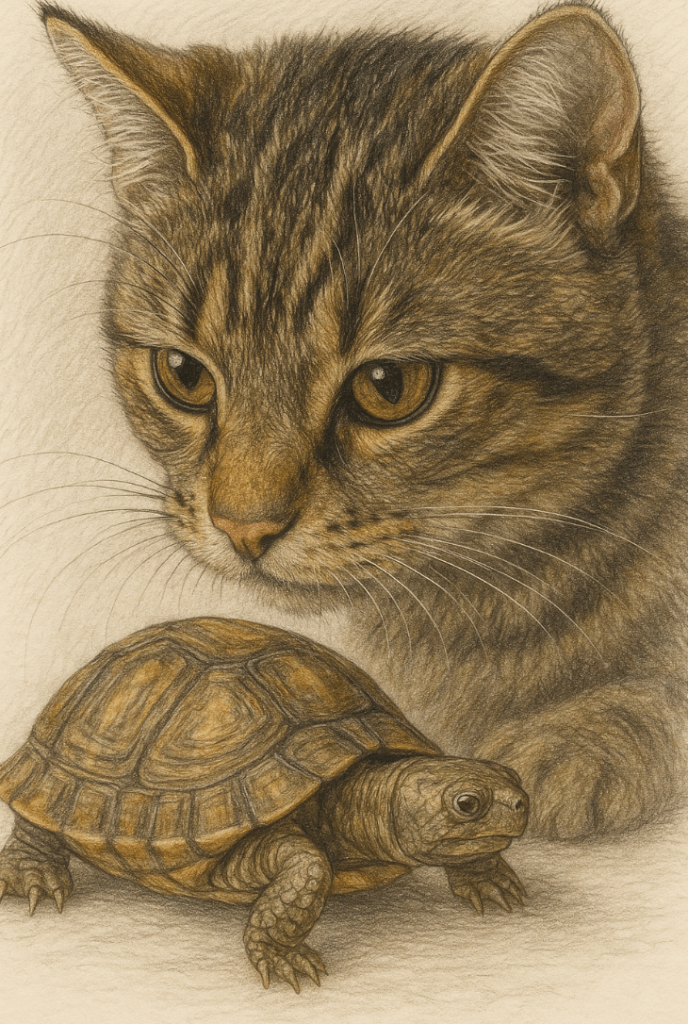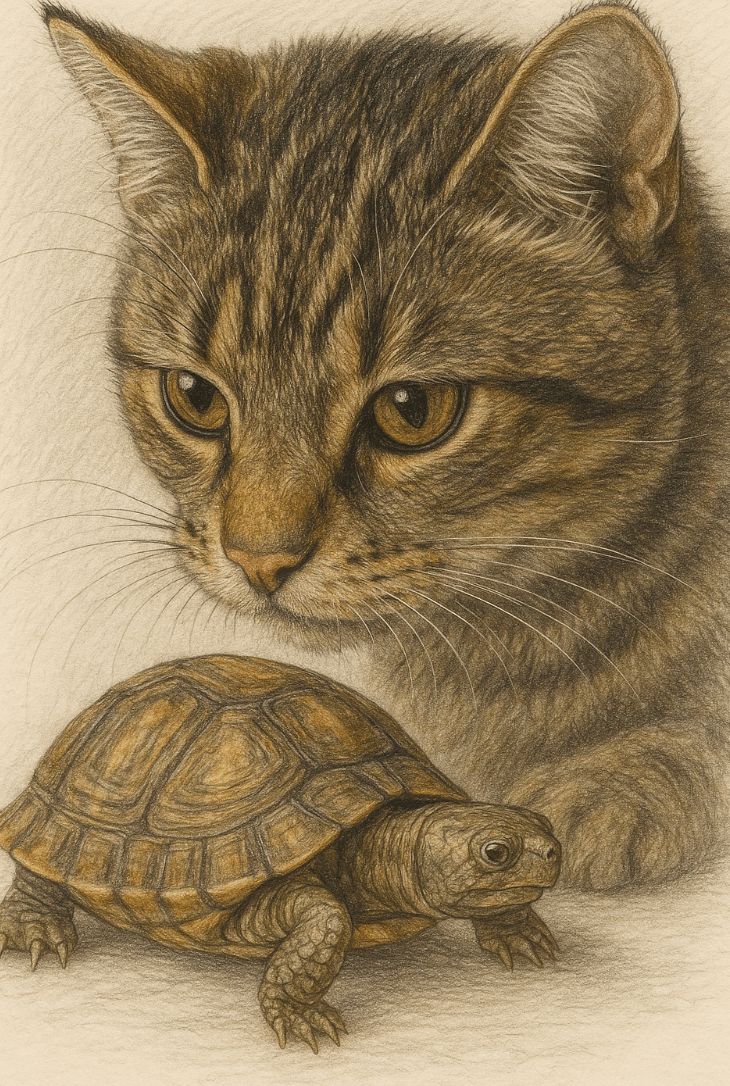Can Cats Eat Turtles? Understanding the Risks and Realities
Cats are naturally curious creatures, and their hunting instincts often lead them to explore the world around them—sometimes in ways we least expect. One question that may arise for pet owners is whether cats can eat turtles. While cats are obligate carnivores and capable hunters, turtles are not typical prey for domestic felines. However, curiosity or hunger might drive a cat to interact with a turtle, raising concerns about safety and health. In this blog post, we’ll delve into the potential risks of cats eating turtles, what to do if your cat shows interest in these reptiles, and how to ensure both your cat and any turtles in your home stay safe and healthy.
Risks of Cats Eating Turtles
While it’s unlikely that a domestic cat would successfully hunt and consume an adult turtle, smaller or juvenile turtles could be vulnerable. If a cat does manage to eat a turtle, several risks need to be considered.
Choking Hazard:
Turtle shells are hard and difficult to chew, posing a choking risk if swallowed whole or in large pieces.Shell Fragments:
Sharp shell fragments can cause injuries to your cat’s mouth, throat, or digestive tract, leading to pain or infection.Toxicity Concerns:
Some turtles carry harmful bacteria like Salmonella, which can be transmitted to your cat (and potentially to humans).Nutritional Imbalance:
Turtles are not a natural part of a cat’s diet and lack the nutrients cats need to thrive, making them an unsuitable food source.Aggressive Retaliation:
Turtles can bite or scratch in self-defense, potentially injuring your cat during an attempted attack.
These risks highlight why cats should never be allowed to eat turtles, even out of curiosity or instinct.
How to Prevent Your Cat from Eating Turtles
If you have a turtle as a pet or live in an area where turtles are common, taking preventive measures is essential to protect both animals. Here are some strategies to keep your cat and turtles safe.
Supervise Interactions:
Never leave your cat and turtle alone together. Supervision ensures you can intervene if your cat shows aggressive or predatory behavior.Create a Safe Space for the Turtle:
Provide your turtle with an enclosed habitat that your cat cannot access, such as a tank with a secure lid or a fenced outdoor enclosure.Redirect Your Cat’s Attention:
Use toys, treats, or interactive play to distract your cat when they show interest in the turtle.Train Your Cat:
Teach your cat commands like “leave it” or “no” to discourage unwanted behaviors around the turtle.Separate Feeding Areas:
Ensure your cat’s food and the turtle’s food are kept far apart to avoid confusion or competition.
By implementing these precautions, you can minimize the chances of your cat attempting to eat or harm a turtle.
Check this guide 👉Can Cats Eat Sea Salt? Best 7 Expert Tips!
Check this guide 👉Can Cats Eat Pork? Best 7 Expert Tips!
Check this guide 👉Can Cats Eat Tripe? Best 7 Expert Tips!

Preventive Measures for Cats and Turtles | Potential Risks of Cats Eating Turtles |
|---|---|
Supervise interactions at all times | Choking on turtle shells |
Use secure enclosures for turtles | Shell fragments causing internal injuries |
Redirect cat’s attention with toys | Exposure to harmful bacteria like Salmonella |
Train your cat to avoid turtles | Nutritional imbalance from eating turtles |
Separate feeding areas | Risk of injury from turtle bites or scratches |
What to Do If Your Cat Eats a Turtle
If your cat manages to eat a turtle or part of one, it’s important to act quickly to address potential health concerns. Follow these steps to ensure your cat’s safety.
Monitor for Symptoms:
Watch for signs of distress, such as vomiting, diarrhea, lethargy, or difficulty breathing, which may indicate internal injuries or infections.Check Their Mouth:
Inspect your cat’s mouth for cuts, abrasions, or lodged shell fragments that could cause discomfort or infection.Contact Your Veterinarian:
Call your vet immediately for advice, especially if your cat consumed a large piece of shell or shows signs of illness.Provide Fresh Water:
Encourage your cat to drink water to help flush out any harmful bacteria they may have ingested.Avoid Home Remedies:
Refrain from attempting to induce vomiting or administer medications without professional guidance, as this could worsen the situation.
Prompt action can prevent complications and ensure your cat receives the care they need.
Understanding Natural Predatory Behavior in Cats
Cats are born hunters, and their instincts often lead them to chase small animals, including turtles. Understanding this behavior can help you manage their interactions more effectively.
Instinctual Hunting Drive:
Even well-fed cats may exhibit hunting behavior due to their evolutionary instincts as predators.Curiosity About Movement:
Turtles’ slow movements can intrigue cats, triggering their desire to investigate or pounce.Play Versus Aggression:
Cats may view turtles as playthings rather than prey, but their actions can still harm the turtle.Territorial Behavior:
Cats may perceive turtles as intruders in their space, leading to defensive or aggressive actions.Training Can Modify Behavior:
With consistent training and positive reinforcement, you can redirect your cat’s instincts toward safer activities.
Recognizing these tendencies helps you anticipate and manage your cat’s interactions with turtles.
Signs Your Cat May Be Interested in Hunting Turtles
Cats often display specific behaviors when they’re curious about or planning to hunt small animals like turtles. Recognizing these signs allows you to intervene before harm occurs.
Staring Intently:
Cats may fixate their gaze on a turtle, indicating they’re considering it as prey.Stalking Movements:
Slow, deliberate crawling or crouching suggests your cat is preparing to pounce.Pawing at the Turtle’s Habitat:
Attempts to reach into the turtle’s enclosure signal curiosity or hunting intent.Chasing Behavior:
If a turtle moves, your cat may instinctively chase it, even if playfully.Vocalizations Near the Turtle:
Growling, chirping, or other sounds may indicate excitement or aggression toward the turtle.
Understanding these behaviors helps you anticipate and redirect your cat’s actions effectively.
Safe Alternatives to Satisfy Your Cat’s Hunting Instincts
If your cat shows interest in hunting turtles, providing alternative outlets for their instincts can help redirect their energy safely.
Interactive Toys:
Feather wands, laser pointers, and toy mice simulate hunting scenarios without endangering other pets.Food Puzzles:
Puzzle feeders encourage mental stimulation and mimic the thrill of “hunting” for food.Window Perches:
Placing a perch near a window allows your cat to observe birds and wildlife safely from afar.Catnip-Filled Toys:
These toys engage your cat’s senses and satisfy their urge to play aggressively.Outdoor Enclosures:
A secure catio provides a safe space for your cat to explore and observe nature without access to turtles or other wildlife.
These alternatives fulfill your cat’s natural desires while keeping other animals safe.
Health Implications for Turtles When Cats Are Present
Turtles face significant risks when living alongside cats, even if the cat doesn’t intend to harm them. Understanding these implications helps you prioritize the turtle’s well-being.
Stress from Harassment:
Constant attention or chasing by a cat can stress turtles, weakening their immune systems over time.Physical Injuries:
Scratches or bites from a cat can introduce infections or damage the turtle’s shell.Disruption of Habitat:
Cats may knock over or disturb the turtle’s tank, altering its environment and causing stress.Exposure to Bacteria:
Cats can transfer harmful bacteria to turtles through contact or shared spaces.Difficulty Recovering from Attacks:
Turtles heal slowly, and injuries inflicted by cats may require veterinary intervention.
Protecting turtles from these risks ensures their health and longevity in a multi-pet household.
Frequently Asked Questions About Cats and Turtles
Is it safe for cats to eat turtles?
No, turtles are not safe for cats to eat due to choking hazards, shell fragments, and potential bacterial contamination.
Can turtles defend themselves against cats?
Yes, turtles can bite or scratch, which may injure your cat during an attempted attack.
What should I do if my cat catches a turtle?
Separate the two animals immediately and inspect both for injuries. Contact your vet if necessary.
How can I keep my turtle safe from my cat?
Use secure enclosures, supervise interactions, and train your cat to avoid the turtle.
Are there health risks for humans if cats eat turtles?
Yes, bacteria like Salmonella can spread to humans through contact with infected animals or their environments.
Promoting Harmony Between Cats and Turtles
While cats and turtles can coexist peacefully, it’s crucial to understand the risks and take proactive measures to ensure their safety. By supervising interactions, providing secure habitats, and addressing predatory instincts, you can create a harmonious environment for both pets. Remember, prevention is key—keeping your cat and turtle safe requires vigilance and commitment. With proper care and attention, you can enjoy the unique companionship these animals bring to your home while minimizing potential conflicts.
Can a Cat Die from a Cold? Best 7 Expert Tips! Learn how to identify, treat, and prevent feline colds while understanding when to seek veterinary care for your cat’s health.
Cat Screaming for Food: Best 7 Expert Tips! Discover effective strategies to manage your cat's food-related vocalizations and create a peaceful feeding routine.
Aspiration Pneumonia in Cats: Best 7 Expert Tips! Discover causes, symptoms, and treatment advice to protect your cat’s respiratory health and ensure a speedy recovery.
Hip Dysplasia in Cats: Best 7 Expert Tips! Discover expert advice on managing hip dysplasia in cats, from symptoms and prevention to treatment options for a happier, healthier feline life.





